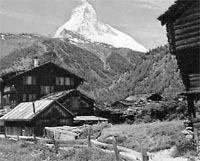Conservation kills
 alarmed by the decline of certain species such as ibex, deer and chamois in the forests of the Alps through hunting, conservationists had urged governments to restrict all activities that would further endanger these animals and disrupt the natural ecology of the Alps. But now, they have discovered that it was not the right thing to do.
alarmed by the decline of certain species such as ibex, deer and chamois in the forests of the Alps through hunting, conservationists had urged governments to restrict all activities that would further endanger these animals and disrupt the natural ecology of the Alps. But now, they have discovered that it was not the right thing to do.
Over the past few decades, tracts of Alpine forests have disappeared - a phenomenon for which the experts had earlier blamed atmospheric pollution. However, only recently, groups of Italian and Swiss scientists have figured out that much of the damage was actually caused by the very animals the conservationists had fought hard to protect. Alpine trees are invaluable to the mountain communities as these protect roads and houses from avalanches and landslides.But over the last 20 or 30 years, older trees have been dying and young ones have failed to mature, thus preventing the regeneration of forests (New Scientist , Vol 158, No 2129).
Renzo Motta of Italy's University of Turin's forestry department has examined the annual growth rings in the tree trunks to record the history of damage done to older trees by animals. The shape and size of a scar in a ring can tell scientists if the damage was caused by a hungry deer stripping and eating bark in the winter, or by one gouging the trees with its horns to mark territory or scrape the velvet off its newly-formed horns. The size of the tree when it was damaged and the height of the scar on the trunk even reveal the species of the culprit. Trees whose bark has been stripped around the trunk die as they are deprived of sap.
In the Gran Bosco di Salbertrand national park in Piedmont, Switzerland, Motta was able to match tree ring marks with data from the park's four-yearly surveys of ungulates. The frequency of the marks followed the population trends closely, falling when annual culling began in 1982, rising when the cull was abandoned officially in 1988 and 1989, and then falling again when it was resumed.
The researchers also found in field surveys that the forests were failing to regenerate because the animals ate the young shoots of saplings. "Pollution may kill older trees, " says Motta, "but ungulates browsing on the younger saplings is the most important factor preventing regeneration." Martin Bissegger of the Swiss Federal Institute of Forest, Snow and Landscape Research near Zurich agrees. All efforts to regenerate Alpine forests have been thwarted by ungulates, he says.
By the late 1800s, red deer, ibex and chamois had been driven to extinction in the Alps by hunters and domestic goats, which competed with them for food. They were reintroduced in the 1910 and 1920s. Today, hunting is restricted, and natural predators such as wolves are extinct. While harsh winters usually kill some ungulates, recent winters have been mild. Meanwhile, hunters in Austria, Germany and Italy have been feeding deer in winter to boost their numbers. "The population, therefore, has grown exponentially," says Motta.
Motta has also interpreted tree rings from forests where deer are not counted directly. Nearly all show massive increases in ungulate damage, especially during the 1980s. Bissegger believes this damage may explain why some tree species have disappeared completely from some areas over the past century.
Related Content
- Insurance to promote human-wildlife coexistence
- Report by the Karnataka State Pollution Control Board regarding illegal mining in Palguni and Nethravathi rivers, Dakshina Kannada district, Karnataka, 09/03/2023
- Inequality kills: the unparalleled action needed to combat unprecedented inequality in the wake of COVID-19
- A future for all: the need for human-wildlife coexistence
- Best Practices of Human Elephant Conflict Management in India
- Namibia: Uproar Over Elephant Killing
